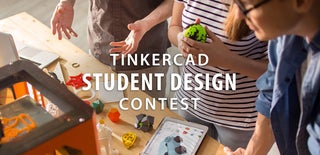Introduction: 4-Cylinder, 2-Stroke Diesel Engine (Make It Move)
This is a simple diesel engine with no brand affiliation. These kinds of models are used to identify how a much more complicated system works in a simpler frame. An engine in a car, all put together with dozens of other systems is incredibly complicated. However, in this model the objective is still clear; it's an engine. The many other systems are not necessary for understanding. This particular model can be modified to fit a certain spec or model, however this original model has no specific design specs or model.
Supplies
A beefy computer with an internet connection
About 6 hours
Patience, lots of it.
Step 1: Build the Camshaft
All engines that use fuel have a camshaft. It converts the powerful up/down motion of the pistons into equally powerful rotating motion. This model is fit for 4 pistons, however modifications allow for more or less. The overall model is not affected by adding or subtracting to the number of pistons, as long as there is at least 1. The camshaft here is 5mm in diameter with 64 sides. The cams are 1mm thick with 3mm spacing in between each other. Take note that they are not all aligned with each other, each cam set is facing a different direction.
Step 2: Build the Pushrods
These are the drivers that turn the camshaft. Here is a great place for detail, like the small screws and holes in the pushrods. The pushrods include a rod to go between the cams and the pushrods, but it is not necessary to the model overall. This model includes them for ease of placing the pushrods in the cams correctly.
Step 3: Build the Pistons
The pistons are what drives the whole engine, explosions of fuel drive them down and the momentum and other pistons push it back up. This is also why the pistons are staggered in various states of up/down. This is another chance to add detail, like piston rings. These take the most of the force and get quite a battering over their lifetime.
Step 4: Visualize Zones and Place Peripherals
This is an important step. Here you want to either do lots of math or move some copies of pistons around to measure the total range of motion that your pistons may move through. Remember that while this is a static model, realism (rather the pseudo-realism here) calls for a range of motion. Directly above the shape to determine your pistons' range of motion, make a new zone to define the combustion chamber. Either on the side or the top, define the tubes where your valves will be placed. 2-4 valves per piston. This is a diesel engine, so we do not need to define a place for a spark plug. This resulting shape is a guide for molding this version of an engine block. Note, your guide shape should be identical for each cylinder.
Step 5: Build Engine Block
Place a block, and using your guide shape from step 4, mold the engine block. In this model, each cylinder is more deconstructed than the last, so I only used 2 on the first 2 pistons.
Step 6: Build Valves
Place your valves into the correct holes in your engine blocks. Make sure to take into account the position of the piston; are the valves letting in fuel? are they sealed? are they letting out exhaust? Most valves commonly have a spring to return them to the "closed" position when sealing the combustion chamber.
Step 7: Build Valve Caps
This is where normally another set of camshafts would be, driving the valves, but they are never commonly seen and are instead kept in a casing, so here the model uses half-cylinders to make caps for the valves.
Step 8: Build Intake/Exhaust Manifolds
This model uses pipe pieces copied from another project as fuel and exhaust pipes. This is where the fuel comes into the engine to be regulated by the valves, and where the exhaust leaves the engine, also regulated by the valves.
Step 9: Build Camshaft Housing
Here, a tube shape that was stretched greatly is used as the bottom of the engine block. Make sure that if the camshaft was spinning, no part of it would contact the engine block.
Step 10: Add the Sides to the Engine Block
A cylinder set to size, then duplicated makes the sides of the engine block.
Step 11: Build the Ends of the Camshaft
One end will just be rod, while the other will have a flywheel that doubles as a belt gear on the rod. The rod could go on to a gearbox or clutch, but this model does not include either.
Step 12: Build Tensioner and Valve Wheels
This is to keep tension on the belt and to spin the camshafts that determine when the valves move.
Step 13: Build Engine Belt
This is a hard part, but this is the engine belt, the timer that causes fuel and exhaust to move correctly and also determines when to ignite a piston in sequence.
Step 14: Scale the Finished Product
The original model is rather small and not designed for viewing but rather for building. When satisfied at the completed model, scale it up as to make it easier to view.

Participated in the
Tinkercad Student Design Contest









